Leaving Fallon, we started experiencing the highs and lows of Great Basin that we had read about. We’d reach a summit or pass of around 7000 feet and drive into a beautiful valley. The beginning of our amazing drive! Our first stop was Austin, the geographical center of the state, a proud little town that even had a walking tour brochure. Today Austin has around 300 residents, and its economy depends on people traveling Hwy. 50, like us.

Austin was a flourishing mining camp and old west town. It sprang into being after William Talcott, an agent for the Overland Mail & Stage, discovered a ledge of silver in May 1862. One year later Austin became the county seat. Within 2 years, the town had 7500 residents, and over $50 million in silver had been found. Around 30 other mining camps were in the area.
As we walked around, it seemed like the International Hotel was the only place open on the street besides the gas station. Great history about this hotel. As we said, it’s the oldest hotel in Nevada. A portion of the bar and east side of the building came from the original International Hotel in Virginia City that had been built in 1859.


The original hotel had been taken town in 1863 to make room for a new and larger International Hotel in Virginia City, so sections of the original building were loaded on wagons and brought to Austin. The sides were rebuilt and the hotel given its original name. Other sections were added over the years, and the completed hotel was famous for its dining room and upstairs ballroom. Emma Nevada, a world famous American Opera singer who came from Austin, made her American debut appearance here. The cafe and bar are still open today.
The main street had some interesting looking buildings from a distance, but nothing was open.

A fascinating building in Austin is Stokes Castle, listed on the National Register of Historic Places. High on a hill, the castle was built in 1897 for Anson Phelps Stokes, an eastern financier and local miner owner. He wanted this to be a replica of a tower outside of Rome and had it constructed out of hand-hewn granite. The huge rocks were then raised into place with a hand-operated windlass.

Its location offers a view of up to 60 miles south and 35 miles north.

As we started walking around town the first day there, we saw these huge crickets everywhere.
Some were alive, but most had been smashed on the road going through town by the huge trucks on the road. We asked the owner of the International Hotel about them, and he said they were Mormon crickets and had started swarming up the street the previous evening. It reminded us of the plague of crickets in Egypt. They got their name from the Mormons who saw great clouds of them as they came through the Great Basin to settle in the west. Even as we drove out of town the last day, we saw remains of hundreds of the crickets and a few still alive. Luckily, they never came around our campground up the hill from the highway.
We (Margie) had a little medical problem while in Austin, so we stayed here a couple of extra days so I could relax and heal.


The nice outcome of staying a couple of days is that we got to finish re-watching Downton Abbey and we were in town for the 4th of July and could see the fireworks just across the street at the park. It was nice to have old fashioned fireworks without music. People from all over came to the park to watch; we hadn’t realized so many people lived in town!

fireworks across . . . 
the road
The explosions and the noise reminded me of what Francis Scott Key must have experienced as he watched his beloved Fort McHenry be bombed by the British. The words of his song are so rich in meaning.
On to Eureka after we learn a little more about the railroad in Austin!






